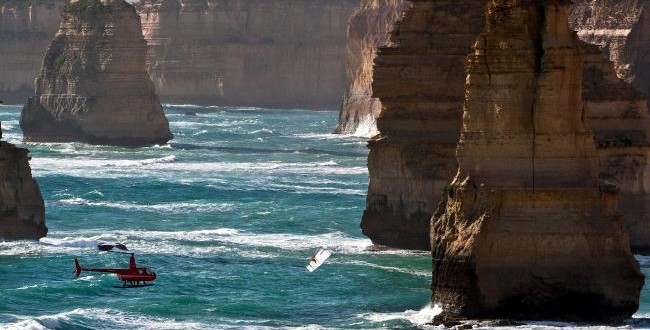Researchers studying the Twelve Apostles in Victoria have discovered five previously unknown limestone stacks underwater.
Dubbed the Drowned Apostles, the surprise find means there has in fact been 17 of the columns in the ocean off the Great Ocean Road.
The never-before-seen sea stacks, located 6km offshore from the Great Ocean Road and 50m beneath the water’s surface, were revealed during sonar mapping of the seafloor off Victoria’s southern coast.
Scientists are dubbing them the “Drowned Apostles”.
While the Drowned Apostles are smaller in both size and number than their more famous cousins, their existence alone is remarkable given their defiance of normal erosion rates.
It is understood to be the first time such limestone stacks have been found preserved in the ocean.
The discovery was made by PhD student Rhiannon Bezore, Associate Professor David Kennedy from the University of Melbourne’s School of Geography and Deakin University’s Dr Daniel Ierodiaconou, who provided the high-resolution sonar data.
“Sea stacks are always eroding, as we saw with the one that collapsed in 2005, so it is hugely surprising that any could be preserved at that depth of water,” Associate Professor Kennedy said.
“They should have collapsed and eroded as the sea level rose.”
Like the Twelve Apostles, the newest additions would have once been part of larger limestone sea cliff.
Ms Bezore, who made the initial discovery in the sonar data, said they probably date back 60,000 years.
“We had to check what we were seeing because no one has seen stacks submerged at this sea level before,” she said.
Only a very fine balance can create sea stacks, with rock needing to be soft enough to erode quickly from a cliff but hard enough to support a rocky pillar, Dr Ierodiaconou said.
Dr Ierodiaconou’s sonar data was collected using the latest advances in multi-beam sonar technology and the team are continuing to fill important knowledge gaps aboard Deakin’s $650,000 research vessel “Yolla”.
The data is part of a project to map the reef estate in Victoria which supports commercial fisheries for southern rock lobster and abalone.
“We are only just starting to understand the biodiversity value of these deep reefs which harbour diverse invertebrate communities, many unknown to science,” he said.
Ms Bezore will present the paper at the International Coastal Symposium in Coogee, Sydney on Thursday morning.
The findings have been published in the US-based Journal of Coastal Research.
Agencies/Canadajournal

 Canada Journal – News of the World Articles and videos to bring you the biggest Canadian news stories from across the country every day
Canada Journal – News of the World Articles and videos to bring you the biggest Canadian news stories from across the country every day


Shocking statistic: 5 out of 17 apostles couldn’t swim … One weird trick to learn to swim; doctors hate it.